137 thousand kilometers of network with a total bandwidth of 8 TB / s

Laying the cable into the ground.

DWDM with connected clients
Hello!
I plan the VimpelCom trunk network - where to go, what to build and so on. I’ll warn you right away that cities are like “material points” for us, other people work inside. We look at them only to get to our main hubs.
')
The length of the backbone network is 137 thousand kilometers , the carrying capacity is already more than 8 Tb / s. Now we have crossed the Urals, we are in Siberia, we are crossing Krasnoyarsk and are planning to get to Chita.
Below - another photo, a story about the equipment and the actions of the cliffs.
The network is growing due to the installation of trunk long-distance cables directly by VimpelCom, the purchase of ready-made communication channels and the rental of networks where there is no our presence. In recent years, the construction of the network has become quite active, since the lease of the networks of the main backbone providers has become quite expensive: requirements for the width of the channel are constantly growing. A few years ago, the necessary resources were in the hundreds of megabytes, and now on many sites already need dozens of gigabytes. This is to some extent due to the increase in the number of subscribers, but to a greater extent - with the growing popularity of Internet services. In the future, experts predict an increase in traffic due to the availability of streaming video and the growth of M2M devices such as various sensors with a SIM card inside.
Now the share of voice traffic in the trunk is only about 5%.
Of course, the need for any construction is determined by the economy, and the more information flows, the better the construction economy. For example, in the direction of the Urals from Moscow - section 440 Gigabit. Radio-relay equipment is very rarely used for communication of intercity nodes (it remains still somewhere in the leased areas), in remote places we use satellite channels (for example, in the north). Most often, we lay the usual cable. Mainly used cable with fibers manufactured by Corning or Fujikura recommendations G.652, then we connect to it the main DWDM equipment.

Racks with DWDM backbone equipment

More racks with trunk DWDM equipment
Sealed gear
If the subscriber makes a telephone call, the “voice” goes through the controller (RNC) to the switch. If it goes to the world wide web, then the packet traffic (date) via SGSN and GGSN goes to the Internet. The backbone network is used to transmit both voice and packet traffic between cities of Russia, and, regardless of distance.
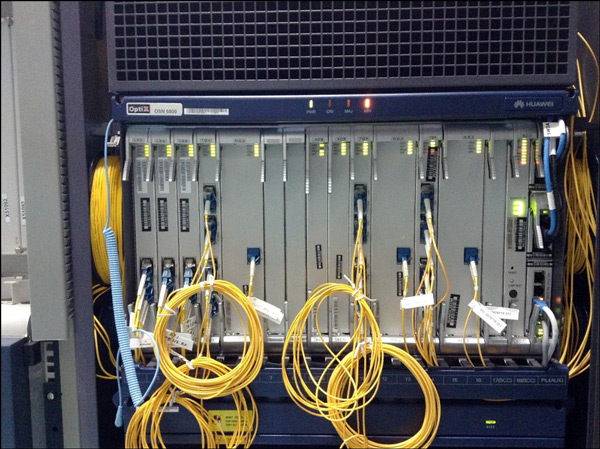
DWDM with connected high-speed client
Between the nodal points (large routers) we use DWDM - spectral channel multiplexing, wavelength division multiplexing. It works like this: the data falls into the spectral compression equipment, through it we forward IP, dedicated channels and so on. The loads are connected in a group signal and are transmitted by one “sneeze” to another city. The key elements of this system are a multiplexer, combining signals, and a demultiplexer performing “unpacking”; the most expensive elements are transponders. Consumers are directly connected to them. The main producers are Ciena and Huawei.
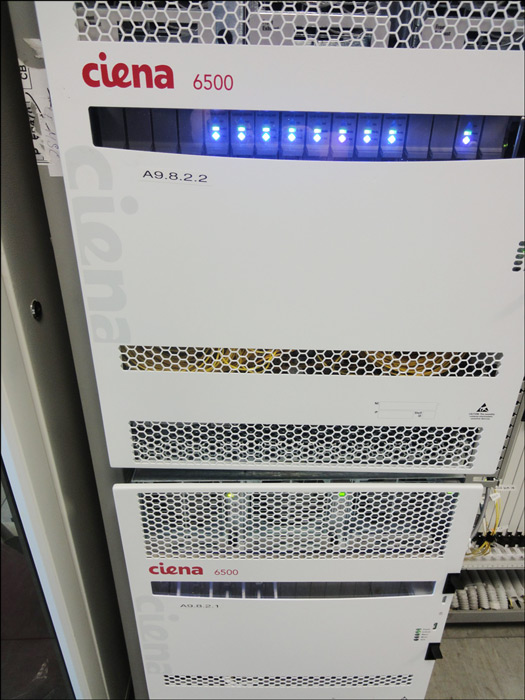
DWDM Ciena - everything works fine (as indicated by blue light bulbs)
We used to use SDH, now we are moving to a flexible and well-scalable DWDM. The transition required a deep modernization of the network with the installation of new equipment at traffic concentration points, as well as along the entire length of the line.
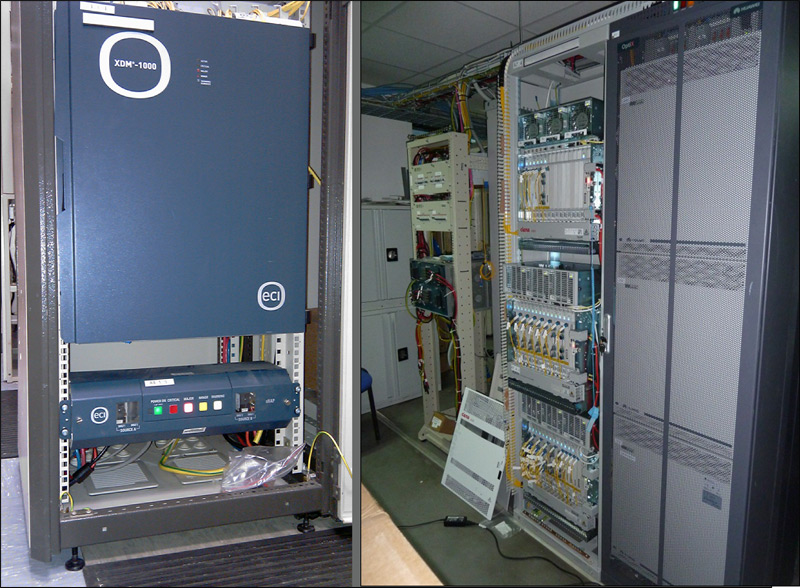
SDH with limited capabilities and DWDM with “unlimited” capabilities
Rings
It is clear that a break in the backbone network means problems for those who remain in an isolated area. Accordingly, many connections are looped, that is, they have at least one backup channel.
True, a couple of years ago, something almost unbelievable happened - in two places the rings almost simultaneously broke two channels. Now we are building slits to increase reliability and protect against double or triple network crashes.
The trunk cables tear more often than it seems, mostly within the city limits. Typical reasons - building without permits, without checking what was buried on the site, sudden repair without approvals. Usually you do not even notice such accidents, because almost everywhere there are rings, and for the network as a whole it is uncritical. We leave, we repair.
Ten years ago, there were many cliffs in the countryside: the villagers watched with interest the laying of the cable in order to dig, cut it with a shovel in search of copper. Now people have already guessed that there is no copper inside the optical cables. In my memory, over the past 10 years, only twice cable breaks were caused by the actions of copper hunters. I also recall how the trunk line was dumping the mudflow, how the excavator interrupted it (in general, the excavator is the enemy of telecommunications No. 1). Once, a pile was driven straight into the cable.
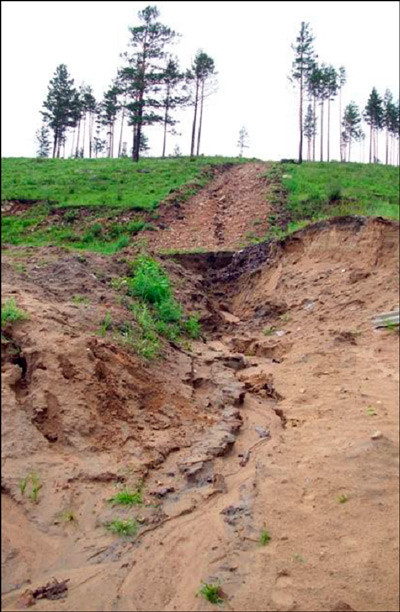
The struggle of people and nature (Sel)
Cliffs
In the event of a cable break, we fix the accident, we inform the service organization at the place with which the contract was concluded (24/7 mode of operation). There are complex cases, especially they are frequent in winter, when the control system is difficult to determine the coordinates of a cable break. Then on-site engineers take a reflectometer and begin to look for a cliff. A reflectometer is such a thing that delivers an optical pulse, and measures the time it takes for the return signal to return from a kink. The device, knowing the speed of the signal, calculates the distance to the accident site. "Shoot" on the one hand, then on the other - it became clear where the cliff. As a rule, the place can be seen - for example, as I said above, a pile sticks out or an excavator stands with fresh earth on a bucket. Sometimes you have to search a little longer, but finding is not a problem. Under ground fiber itself does not break, something is always visible on the surface.
The crew makes a repair insert - a damaged cable is cut, usually 20-120 meters. It is clear that the insertion degrades the signal-to-noise ratio, but the lines are built with a margin of 3 decibels (this margin will allow to build about 15 kilometers of inserts). There are places (for example, in the Caucasus), where 20 accidents took place on the line already, there is enough reserve. The data transfer rate from the inserts does not fall, the characteristics of the line deteriorate. In practice, such that because of the inserts had to shift the cable until it was.
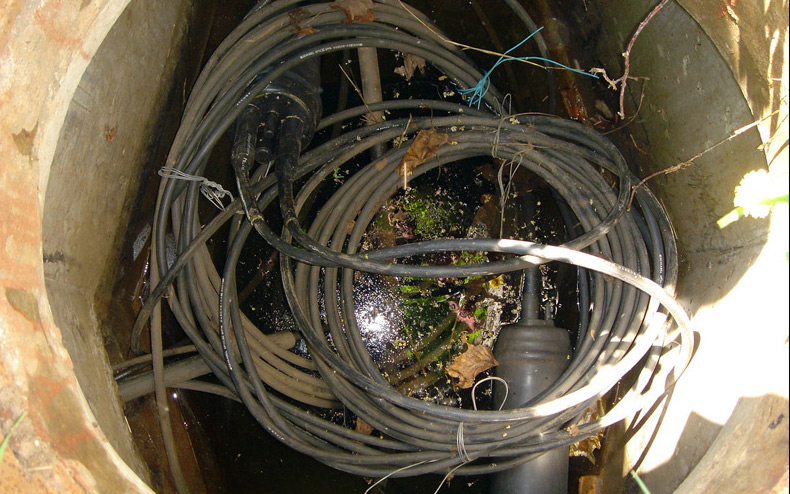
Laying of the coupling in the cable sewerage
New plot
When a new section of the network is needed, we prepare a business case and count the costs. Plus, we add data on the fact that we will save when we refuse to rent, commercial experts estimate how many additional sales there will be due to the possibility of providing a wider range of services. We give the plan to the financiers, they give an opinion, build or not. Next is a detailed technical solution that allows you to hire a contractor and build.

Input of optical cable into communication container
Now we try to bury the cable as much as possible in a protective polyethylene pipe - this is the most favorable method. Not everywhere it turns out. Where there is no possibility, we pull the suspension, using the supports of the power networks or urban services ... Between cities - the optical cable can be placed in the ground wire of power lines, or use a self-supporting cable along the lighting poles. Communication cables in the subway are well protected, but there are no trunk lines as such, the usual ones are local networks, and this is no longer my element.
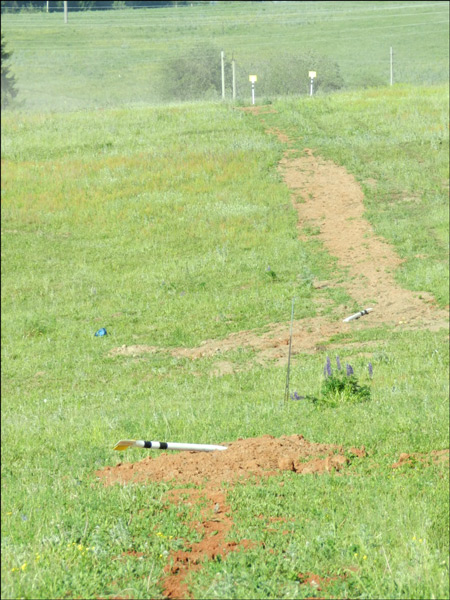
Information notices a couple of years after installation

Cable descent from power line poles

NRP
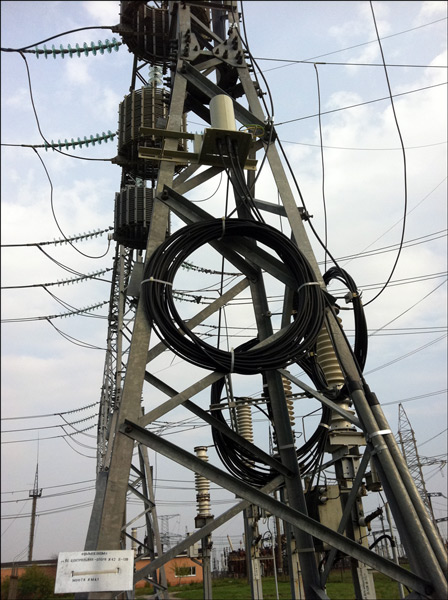
The stock of optical cable on the support
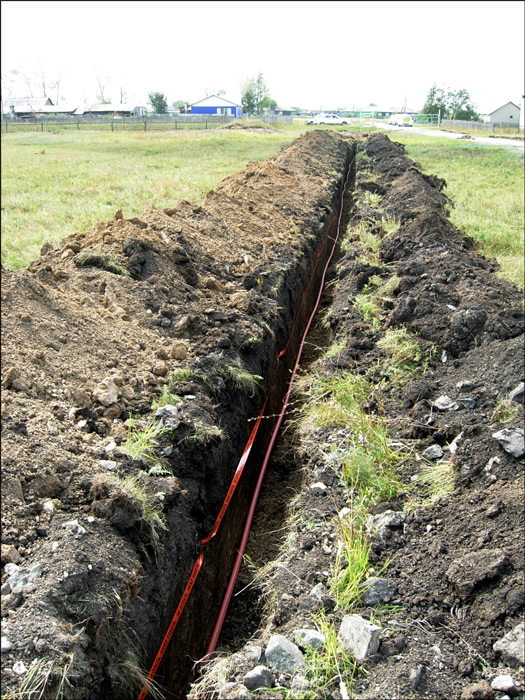
Laying the optical cable (in the PZT) in the ground
The average timing of the implementation of trunk intercity projects, depending on the complexity of the soil, the nature of landowners range from one to two, three years. The construction finals of the Mg highway are: inspection of the site with certified measuring equipment, commissioning of the line. A reputable commission is gathered, a bunch of acts, documents and permits are issued. All this is called a beautiful word - legalization. After that - hooray. Line earned.
Source: https://habr.com/ru/post/187508/
All Articles